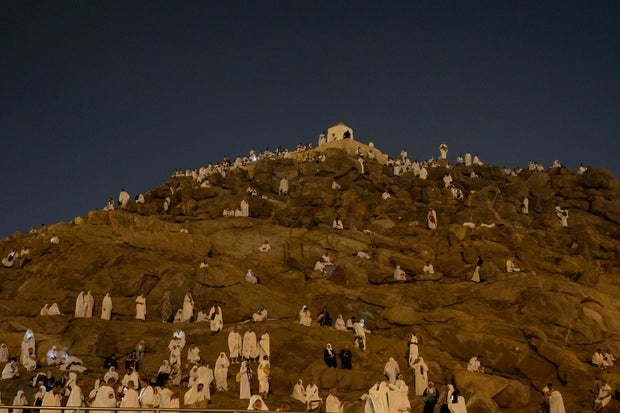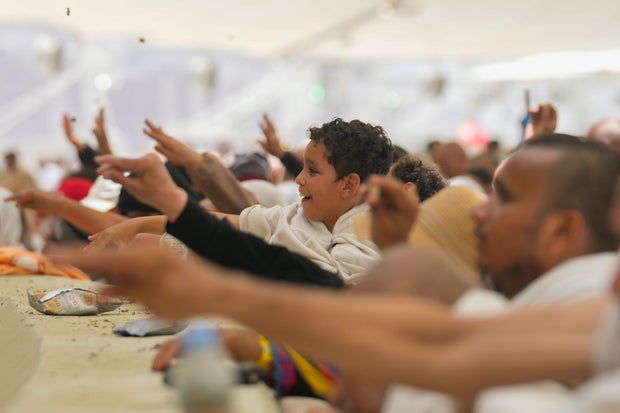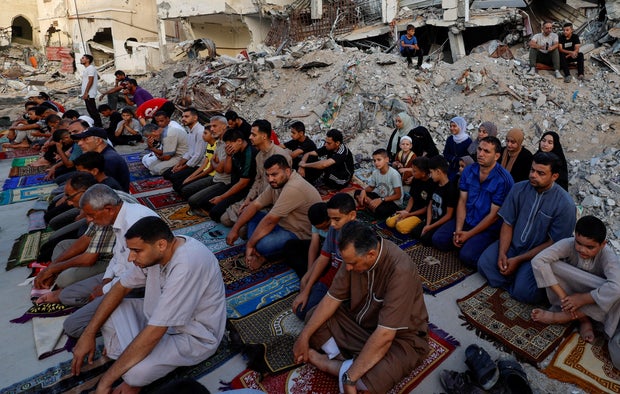Masses of pilgrims on Sunday embarked on a symbolic stoning of the devil in Saudi Arabia under the soaring summer heat. The ritual marks the final days of the Hajj, or Islamic pilgrimage, and the start of the Eid al-Adha celebrations for Muslims around the world.
The stoning is among the final rites of the Hajj, which is one of the Five Pillars of Islam. It came a day after more than 1.8 million pilgrims congregated at a sacred hill, known as Mount Ararat, outside the holy city of Mecca, which Muslim pilgrims visit to perform the annual five-day rituals of Hajj.
The pilgrims left Mount Arafat on Saturday evening to spend their night in a nearby site known as Muzdalifa, where they collected pebbles to use in the symbolic stoning of pillars representing the devil.
Rafiq Maqbool / AP
The pillars are in another sacred place in Mecca, called Mina, where Muslims believe Ibrahim’s faith was tested when God commanded him to sacrifice his only son Ismail. Ibrahim was prepared to submit to the command, but then God stayed his hand, sparing his son. In the Christian and Jewish versions of the story, Abraham is ordered to kill his other son, Isaac.
On Sunday morning, crowds headed on foot to the stoning areas. Some were seen pushing disabled pilgrims on wheelchairs on a multi-lane road leading to the complex housing the large pillars. Most pilgrims were seen sweltering and carrying umbrellas to protect them against the burning summer sun.
An Associated Press reporter saw many pilgrims, especially among the elderly, collapsing on the road to the pillars because of the burning heat. Security forces and medics were deployed to help, carrying those who fainted on gurneys out of the heat to ambulances or field hospitals. As the temperature spiked by midday, more people required medical help. The heat had reached to 47 C (116.6 F) in Mecca, and 46 C (114.8 F) in Mina, according to Saudi meteorological authorities.
Despite the suffocating heat, many pilgrims expressed joy at being able to complete their pilgrimage.
“Thank God, (the process) was joyful and good,” said Abdel-Moaty Abu Ghoneima, an Egyptian pilgrim. “No one wants more than this.”
Mohamad Torokman / REUTERS
Many pilgrims will spend up to three days in Mina, each casting seven pebbles at three pillars in a ritual to symbolize the casting away of evil and sin.
While in Mina, they will visit Mecca to perform their “tawaf,” or circumambulation, which is circling the Kaaba in the Grand Mosque counterclockwise seven times. Then another circumambulation, the Farewell Tawaf, will mark the end of Hajj as pilgrims prepare to leave the holy city.
The rites coincide with the four-day Eid al-Adha, which means “Feast of Sacrifice,” when Muslims with financial means commentate Ibrahim’s test of faith through slaughtering livestock and animals and distributing the meat to the poor.
Most countries marked Eid al-Adha on Sunday. Others, like Indonesia, will celebrate it Monday.
Once the Hajj is over, men are expected to shave their heads and remove the shroud-like white garments worn during the pilgrimage, and women to snip a lock of hair in a sign of renewal and rebirth.
Most of the pilgrims then leave Mecca for the city of Medina, about 340 kilometers (210 miles) away, to pray in Prophet Muhammad’s tomb, the Sacred Chamber. The tomb is part of the prophet’s mosque, one of the three holiest sites in Islam, along with the Grand Mosque in Mecca and the Al Aqsa Mosque in Jerusalem.
Rafiq Maqbool / AP
All Muslims are required to make the Hajj once in their lives if they are physically and financially able to do so. Many wealthy Muslims make the pilgrimage more than once. The rituals largely commemorate the accounts of Prophet Ibrahim and his son Prophet Ismail, Ismail’s mother Hajar and Prophet Muhammad, according to the Quran, Islam’s holy book.
More than 1.83 million Muslims performed Hajj in 2024, Saudi Hajj and Umrah Minister Tawfiq bin Fawzan al-Rabiah said in a briefing, slightly less than last year’s figures when 1.84 million made the rituals.
Most of the Hajj rituals are held outdoors with little if any shade. It is set for the second week of Dhu al-Hijjah, the last month in the Islamic lunar calendar, so its time of the year varies. And this year the pilgrimage fell in the burning summer of Saudi Arabia.
This year’s Hajj came against the backdrop of the devastating Israel-Hamas war, which has pushed the Middle East to the brink of a regional conflict.
Palestinians in the Gaza Strip weren’t able to travel to Mecca for Hajj this year because of the closure of the Rafah crossing in May when Israel extended its ground offensive to the city on the border with Egypt. And they will not be able to celebrate the Eid al-Adha as they used to do in previous years.
Dozens of Palestinians gathered Sunday morning near a destroyed mosque in Gaza’s southern city of Khan Younis to perform the Eid prayers. They were surrounded by debris and rubble of collapsed houses. In the nearby town of Deir al-Balah in central Gaza, Muslims held their prayers in a school-turned shelter. Some, including women and children, went to cemeteries to visit the graves of loved ones.
Mohammed Salem / REUTERS
“Today, after the ninth month, more than 37,000 martyrs, more than 87,000 wounded, and hundreds of thousands of homes were destroyed,” Abdulhalim Abu Samra, a displaced Palestinian, told the AP after wrapping up the prayers in Khan Younis. “Our people live in difficult circumstances.”
Also in the occupied West Bank, Palestinians convened for the Eid prayers in Ramallah, the seat of the Western-backed Palestinian Authority. “We suffer greatly and live through difficult moments with (what’s happening to) our brothers in Gaza,” said Mahmoud Mohana, a mosque imam.
In Yemen’s Houthi-held capital of Sanaa and in Iraq’s capital, Baghdad, Muslims celebrated and prayed for the war-weary Palestinians in Gaza.
“We are happy because of Eid but our hearts are filled with anguish when we see our brothers in Palestine,” said Bashar al-Mashhadani, imam of al-Gilani Mosque in Baghdad. “(We) urge the Arabic and Islamic countries to support and stand beside them in this ordeal.”
In Lebanon where the militant Hezbollah group traded nearly daily attacks with Israel, a steady stream of visitors made their way into the Palestine Martyrs Cemetery near the Shatila Palestinian refugee camp in Beirut early Sunday morning, bearing flowers and jugs of water for the graves of their loved ones, an annual tradition on the first day of Eid.
The cemetery is the burial site of many Palestinian Liberation Organization leaders and militants who died fighting Israeli forces in Lebanon in the 1970s and ’80s. More recently, top Hamas official Saleh al-Arouri and two other Hamas members, killed with him in an apparent Israeli airstrike in Beirut’s southern suburbs in January, were buried there.





